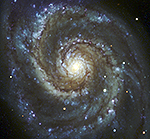
Montage Montage is an astronomical image toolkit with components for reprojection, background matching, coaddition and visualization of FITS files. It can be used as a set of command-line tools (Linux, OS X and Windows), C library calls (Linux and OS X) and as Python binary extension modules.
The Montage source is written in ANSI-C and code can be downloaded from GitHub ( https://github.com/Caltech-IPAC/Montage ). The Python package can be installed from PyPI ("</i>pip install MontagePy"). The package has no external dependencies. See http://montage.ipac.caltech.edu/ for details on the design and applications of Montage.
MontagePy.main modules: mHistogram¶
The Montage image visualizer mViewer uses a histogram of the image values to determine the best stretch for display. However, if we wish to use the same stretch for a set of images (e.g., for tiled displays) we need to tie them all to the same histogram. mHistogram uses the same code as mViewer to generate the histogram and color stretch bins and mViewer has an option to import this data instead of calculating it itself.
from MontagePy.main import mHistogram, mViewer
help(mHistogram)
mHistogram Example:¶
mViewer does not use the histogram directly but rather a set of stretch levels based on the histogram and the type of stretch the user wants. There are several different stretches, from simple linear to a couple of gaussian-weighted histogram equalization techniques. Even the starting and ending levels may be histogram-based and couched in terms of the distribution "sigma" values.
We will use the latter approach for this example:
rtn = mHistogram("M17/mosaic.fits", "work/M17/M17.hist", "-2s", "max", "gaussian-log")
print(rtn)
lncnt = 0
with open("work/M17/M17.hist", "r") as file:
for line in file:
print(line, end='')
lncnt = lncnt + 1
if lncnt > 500:
print('\n(Truncated at 500 lines)')
break
Error Handling¶
If mHistogram encounters an error, the return structure will just have two elements: a status of 1 ("error") and a message string that tries to diagnose the reason for the error.
For instance, if the user specifies an image that doesn't exist:
rtn = mHistogram("M17/unknown.fits", "work/M17/M17.hist", "-2s", "max", "gaussian-log")
print(rtn)
Classic Montage: mHistogram as a Stand-Alone Program¶
mHistogram Unix/Windows Command-line Arguments¶
mHistogram can also be run as a command-line tool in Linux, OS X, and Windows:
Usage: mHistogram [-d] -file in.fits minrange maxrange [logpower/gaussian/gaussian-log/asinh [asinh-beta]] -out out.hist
If you are writing in C/C++, mHistogram can be accessed as a library function:
/*-*********************************************************************************************/
/* */
/* mHistogram */
/* */
/* This program is essentially a subset of mViewer containing the code that determines */
/* the stretch for an image. With it we can generate stretch information for a whole */
/* file (or one reference file), then use it when we create a set of JPEG/PNG files */
/* from a set of other subsets/files. */
/* */
/* Only one file is processed, so if we want color we need to run this program three */
/* times. The only arguments needed are the image / stretch min / stretch max / mode. */
/* */
/* char *imgFile Input FITS file. */
/* char *histFile Output histogram file. */
/* char *minString Data range minimum as a string (to allow '%' and 's' suffix. */
/* char *maxString Data range maximum as a string (to allow '%' and 's' suffix. */
/* char *stretchType Stretch type (linear, power(log**N), sinh, gaussian or gaussian-log) */
/* */
/* int grayLogPower If the stretch type is log to a power, the power value. */
/* char *betaString If the stretch type is asinh, the transition data value. */
/* */
/* int debug Debugging output level. */
/* */
/***********************************************************************************************/
struct mHistogramReturn *mHistogram(char *grayfile, char *histfile,
char *grayminstr, char *graymaxstr, char *graytype, int graylogpower, char *graybetastr, int debugin)
Return Structure
struct mHistogramReturn
{
int status; // Return status (0: OK, 1:ERROR)
char msg [1024]; // Return message (for error return)
char json[4096]; // Return parameters as JSON string
double minval; // Data value associated with histogram minimum.
double minpercent; // Percentile value of histogram minimum.
double minsigma; // 'Sigma' level of histogram minimum.
double maxval; // Data value associated with histogram maximum.
double maxpercent; // Percentile value of histogram maximum.
double maxsigma; // 'Sigma' level of histogram maximum.
double datamin; // Minimum data value in file.
double datamax; // Maximum data value in file.
};